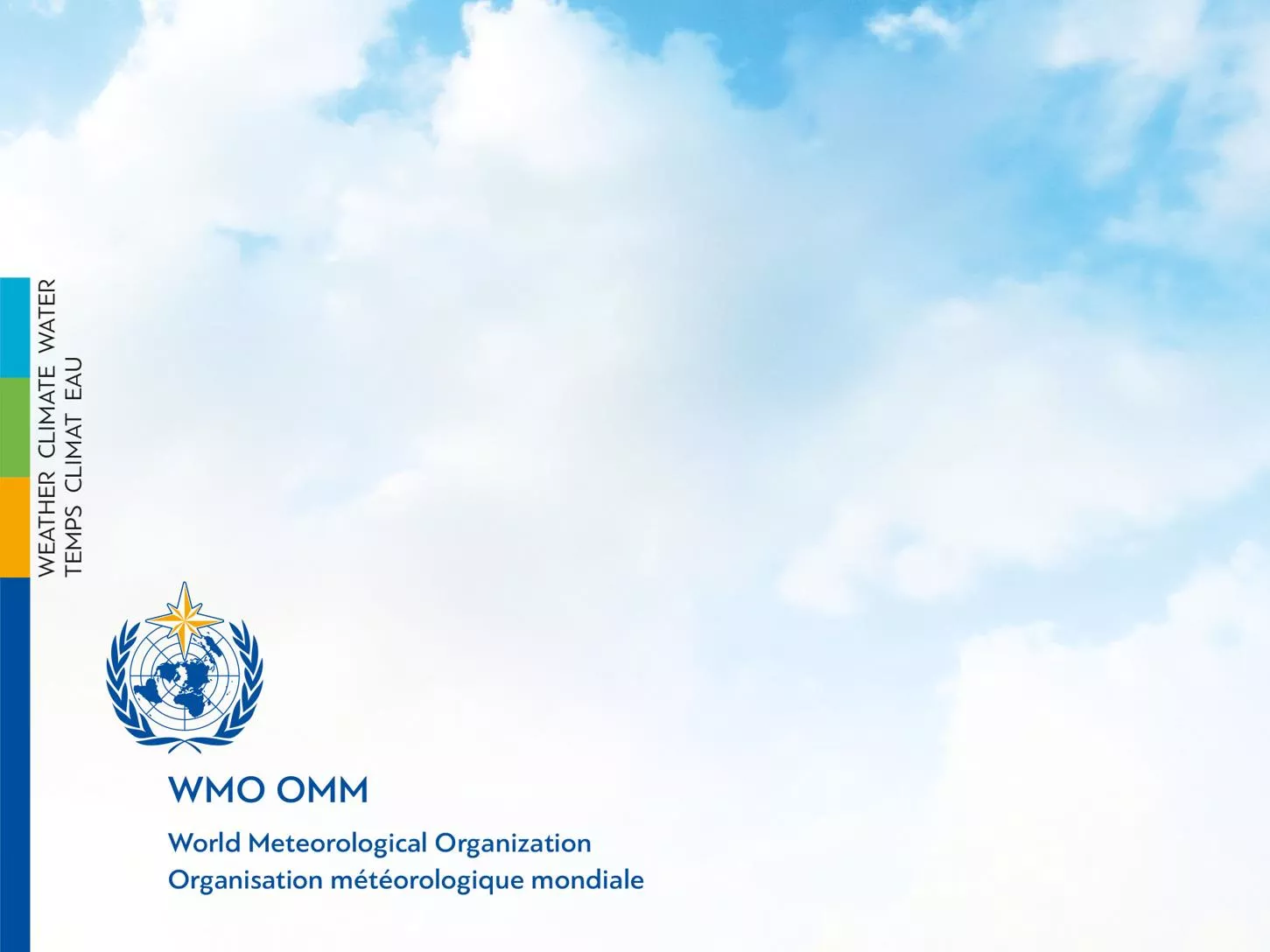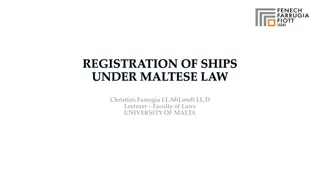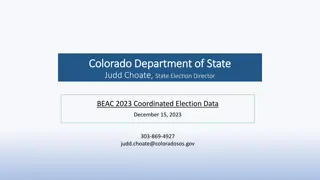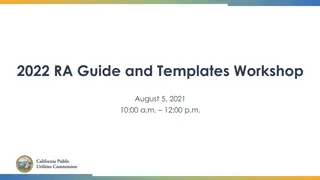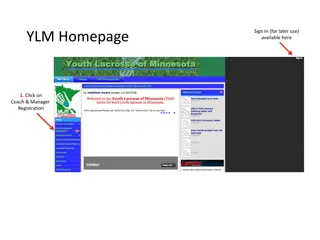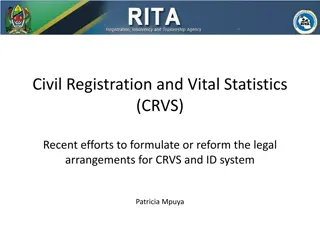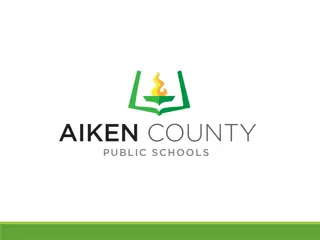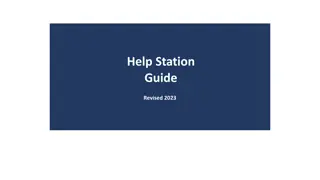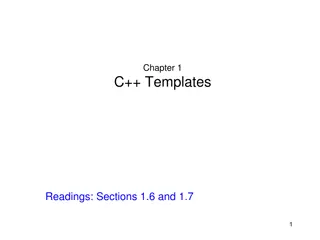Streamlining Station Registration Process with Class Templates
Revolutionize the station registration process through the use of class templates, reducing manual input time and repetitive steps. Explore how templates can simplify the registration, editing, and closing procedures for various station types. Discover the concept of templates and examples like Surface Land Meteorological Station, Automatic Weather Station, and more.
Download Presentation

Please find below an Image/Link to download the presentation.
The content on the website is provided AS IS for your information and personal use only. It may not be sold, licensed, or shared on other websites without obtaining consent from the author. Download presentation by click this link. If you encounter any issues during the download, it is possible that the publisher has removed the file from their server.
E N D
Presentation Transcript
Webinar #7 04.03.2019 OSCAR station class templates -first ideas and brainstorming-
Agenda Welcome OSCAR station class templates (Luisa) Discussion
General idea To manually register a new station takes time and depending on the station type involves repetitive steps, e.g. registration of a new Upper air/Radiosounding station
General idea To manually register a new station takes time and depending on the station type involves repetitive steps, e.g. registration of a new Upper air/Radiosounding station
General idea Easier input using templates Register new station: select station type -> custom input form Template depending on station class Templates on regional, national level Templates could be used for registration, editing(?), closing(?)
Concept of Templates 1. Presence or absence of specific WMDS fields 2. Predefined values for certain WMDS fields 3. Class specific labels describing WMDS fields (e.g. GCW template) 4. Correlation between WMDS fields (time schedule and deployments defined once and propagated for all observations)
New station class templates Surface land meteorological station (synop) Automatic Weather Station (AWS) Upper-air station/Radiosonde station Upper-air station/Pilot station Radar wind profiler station Global Cryosphere Watch Station
Example station class: Upper air/Radiosonde Template Vaisala.com
Example station class: Upper air/Radiosonde Template Mock up
Example station class: Upper air/Radiosonde Template Necessary input: Station basics (station name, WIGOS-ID, date established, coordinates, country, WMO-region) Program/network Deployment date Observing method: Radiosonde tracking information
Example station class: Upper air/Radiosonde Template Pre-defined: Station type: land (fixed) Variables: humidity > watervapor profile pressure > atmospheric pressure profile temperature > temperature profile wind > upper wind (X,Y components, horizontal) Geometry (for all variables): vertical profile Deployments (for all variables): Instrument characteristics: Observing method: radiosonde (tracking has to be specified)
Open Questions Which templates are useful? Planned: Surface land meteorological station (synop) Automatic Weather Station (AWS) Upper-air station/Radiosonde station Upper-air station/Pilot station Radar wind profiler station Global Cryosphere Watch Station Would it be good to be able to create national/regional templates?
Open Questions What would you like to mostly use templates for? Registration of stations? Editing of station classes? Closing of station classes? How should a template based editing of a station look like? How should closing look like/what should it do?
Thank you Merci
New station classes (template) Surface land meteorological station (synop) Surface marine meteorological station (synop) Automatic Weather Station (AWS) Climatological station Radiation station Upper-air/Radiosonde station Upper-air/Pilot station Radar wind profiler station Aircraft meteorological station Sea profiling station Weather radar station Precipitation station Agricultural meteorological station Cryosphere Station (template: Global Cryosphere Watch Station)
Station class Characteristics of this station class which will be reflected in the template Surface land meteorological station (synop) Predefined fields: Station type: land (fixed) Variables: humidity -> humidity (at specified distance from reference surface), pressure -> atmospheric pressure, temperature -> air temperature (at specified distance from reference surface), wind -> horizontal wind direction at specified distance from reference surface, wind -> horizontal wind speed at specified distance from reference surface
Station class Characteristics of this station class which will be reflected in the template Automatic station (AWS) Predefined fields: Station type: land (fixed) Variables: humidity -> humidity (at specified distance from reference surface), pressure -> atmospheric pressure, temperature -> air temperature (at specified distance from reference surface), wind -> horizontal wind direction at specified distance from reference surface, wind -> horizontal wind speed at specified distance from reference surface Default options: source of observation -> instrumental automatic reading (automatically produced measurement result) for at least one of the above mentioned variables
Station class Characteristics of this station class which will be reflected in the template Upper-air/Radiosonde station Predefined fields: Station type: land (fixed) Variables: humidity > watervapor profile, pressure > atmospheric pressure profile, temperature > temperature profile, wind > upper wind (X,Y components, horizontal) Geometry (for all variables): vertical profile Deployments (for all variables): General information: Source of observation: Instrumental automatic reading Deployments (for all variables): Instrument characteristics: Observing method: radiosonde (tracking has to be specified) Default options: Radiosonde tracking information
Station class Characteristics of this station class which will be reflected in the template Upper-air/Pilot station Predefined fields: Station type: land (fixed) Variables: wind > upper wind (X,Y components, horizontal) Geometry: vertical profile Deployments: General information: Source of observation: Instrumental automatic reading Deployments: Instrument characteristics: Observing method: radiosonde with composite method tracking
Station class Characteristics of this station class which will be reflected in the template Radar wind profiler station Predefined fields: Station type: land (fixed) Program: GOS -> GOS Other elements -> Wind Profilers Default options: Variables: Upper wind (X, Y components, horizontal) and/or Horizontal wind direction at specified distance from reference surface and/or Horizontal wind speed at specified distance from reference surface
Station class Characteristics of this station class which will be reflected in the template Predefined fields: Program: GCW Default options: Variables: Ocean (sea ice cover, sea ice elevation, sea ice motion, sea ice surface characteristics, sea ice surface temperature, sea ice thickness, sea ice type), Terrestrial (Lake: ice thickness, River: ice thickness, Land surface: glacier cover, glacier motion, glacier topography, ice sheet topography, permafrost, depth of fresh snowfall, snow cover, snow depth, snow status, snow water equivalent) Global Cryosphere Watch station
Example station class: Upper air/Radiosonde Template JSON file templatename : radiosonde , user input fields": ["name", "dateEstablished", "wigosIds", "territoryName", "wmoRaName", "stationPrograms", {"locations":["latitude", "longitude", "elevation" ]}, deplSince ,{ ObservingMethod :[ radiosonde with NAVAID , radiosonde with composite method tracking , radiosonde with radar tracking , radiosonde with radiotheodolite tracking ]}] "predefined": [{"typeName": "Land (fixed) "}, {"observations": [{"variableName": "Atmospheric pressure profile"}, {"geometryName": "Vertical profile"}, {"variableName": "Temperature profile"}, {"geometryName": "Vertical profile"}, {"variableName": "Upper wind (X, Y components, horizontal) "}, {"geometryName": "Vertical profile" }, {"variableName": "Watervapor profile"}, {"geometryName": "Vertical profile"}]}] "populate": ["observations": [{"variablelist", "programs": [{"program": "stationPrograms"}]], "observations": [{"variablelist", "deployments": [{"deplSince": "dateEstablished"}]], "observations": [{"variablelist", "deployments": [{"sourceOfObservation": "InstrumentalAutomaticReading"}]], "observations": [{"variablelist , "deployments": [{"ObservingMethod": "radiosondeTracking"}]], "observations": [{"variablelist", "deployments": [{"Schedule": "obsfreq"}]]] } {



